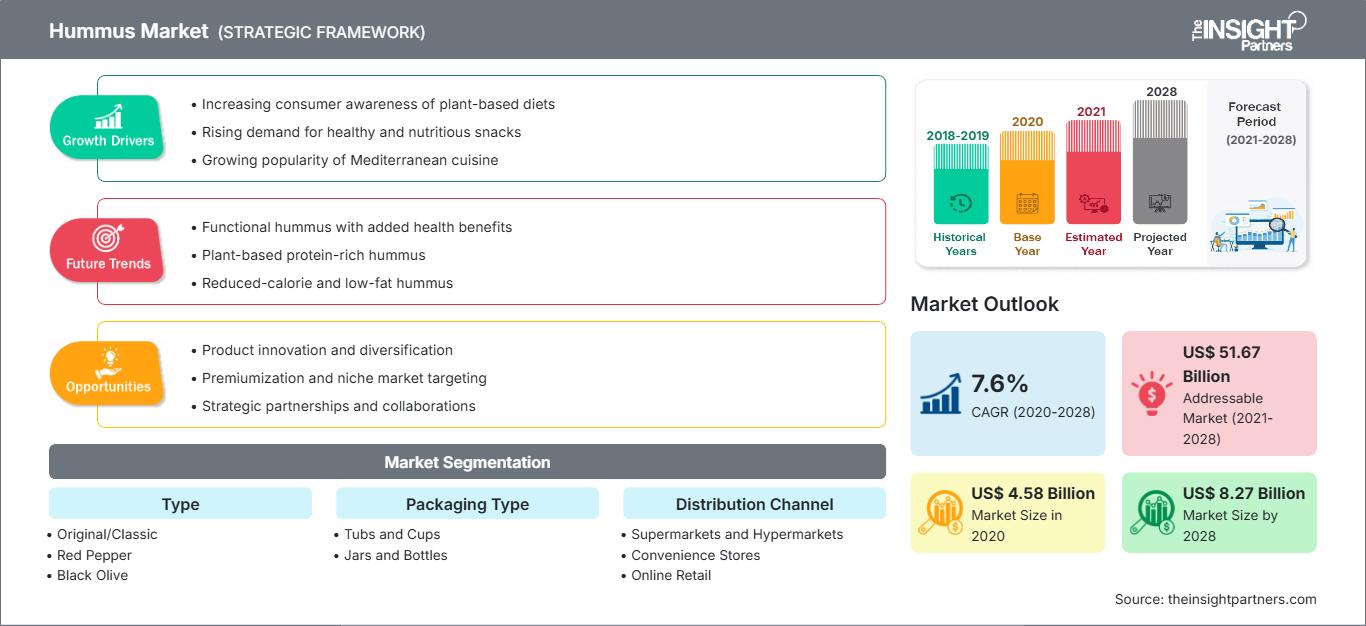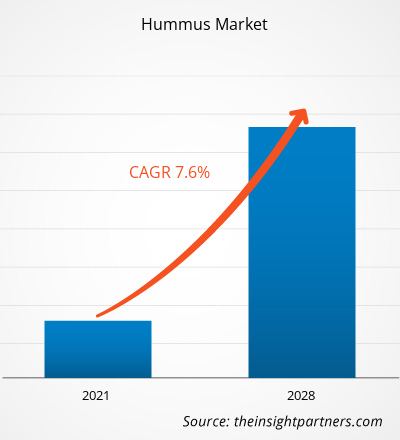El mercado del hummus se valoró en US$ 4.577,35 millones en 2020 y se proyecta que alcance los US$ 8.267,07 millones en 2028; se espera que crezca a una CAGR del 7,6% de 2021 a 2028.
El hummus es una conocida salsa para untar de Oriente Medio con un alto contenido en minerales, vitaminas, proteínas y fibra. Todos sus ingredientes principales (garbanzos, ajo, semillas o pasta de sésamo (tahini) y aceite de oliva) son reconocidos como superalimentos. Los garbanzos son ricos en hierro, fósforo y vitaminas del complejo B. El tahini tiene un alto contenido de zinc, calcio, cobre y fósforo. El zumo de limón es una excelente fuente de vitamina C y antioxidantes. El ajo, que aporta sabor al hummus, está enriquecido con antioxidantes, oligoelementos y vitaminas.
Se espera que el mercado del hummus en Asia-Pacífico alcance su mayor CAGR entre 2021 y 2028. Con el crecimiento económico y la creciente prevalencia de diversas enfermedades, los estilos de vida y los patrones de consumo han cambiado en países como India, China y Japón. Además, la tendencia al veganismo está en auge debido a la creciente concienciación sobre la necesidad de proteger el medio ambiente. La creciente demanda de proteínas vegetales y la creciente concienciación sobre la salud son los principales factores que impulsan el crecimiento del mercado en la región. Asimismo, Europa también está experimentando una alta demanda de proteínas vegetales debido a la creciente adopción del veganismo, especialmente en el Reino Unido. Además, los fabricantes de hummus están ampliando sus líneas de productos con el lanzamiento de variantes orgánicas, así como innovadoras y sabrosas variedades.
La pandemia de COVID-19 ha afectado negativamente el rendimiento del mercado del hummus, principalmente debido a la interrupción de la producción de materias primas y las cadenas de suministro, la incertidumbre climática y otras razones. El brote afectó la eficiencia operativa y las cadenas de valor debido al cierre repentino de las fronteras nacionales e internacionales. Sin embargo, con muchas economías esforzándose por reactivar y normalizar sus operaciones, se prevé que la demanda de hummus aumente en el futuro previsible. Además, la creciente preferencia por un estilo de vida saludable y el cambio de enfoque hacia alimentos que refuerzan el sistema inmunitario seguirán contribuyendo al crecimiento del mercado del hummus en los próximos años. Asimismo, es probable que los fabricantes de hummus aprovechen los canales de distribución en línea para expandir su negocio. Esto se debe principalmente a la creciente preferencia por pedir consumibles en línea para evitar aglomeraciones y respetar las normas de distanciamiento social. Los canales minoristas de alimentos ya operan bajo estrictas normas sanitarias; sin embargo, muchos están tomando precauciones adicionales para minimizar el contacto entre personas. Algunas de las medidas de seguridad seguidas por las empresas incluyen limitar el contacto directo con los conductores de camiones y otros visitantes, comunicar y resaltar las prácticas de higiene adecuadas, y realizar saneamientos completos y eliminar las posibilidades de contacto del personal durante los cambios de turno.
Recibirá personalización de cualquier informe, sin cargo, incluidas partes de este informe o análisis a nivel de país, paquete de datos de Excel, y además aprovechará grandes ofertas y descuentos para empresas emergentes y universidades.
Mercado del hummus: perspectivas estratégicas

-
Obtenga las principales tendencias clave del mercado de este informe.Esta muestra GRATUITA incluirá análisis de datos, desde tendencias del mercado hasta estimaciones y pronósticos.
Perspectivas del mercado
Los beneficios para la salud gracias a su rico perfil nutricional, que incluye proteínas, fibras, vitaminas y minerales, impulsan el crecimiento del mercado.
El hummus es una conocida salsa para untar de Oriente Medio con un alto contenido en minerales, vitaminas, proteínas y fibra. Todos sus ingredientes principales (garbanzos, ajo, semillas o pasta de sésamo (tahini) y aceite de oliva) son reconocidos como superalimentos. Los garbanzos son ricos en hierro, fósforo y vitaminas del complejo B. El tahini tiene un alto contenido de zinc, calcio, cobre y fósforo. El zumo de limón es una excelente fuente de vitamina C y antioxidantes. El ajo, que le da sabor al hummus, es rico en antioxidantes y contiene numerosos oligoelementos y vitaminas. La creciente prevalencia de enfermedades como accidentes cerebrovasculares, cardiopatías isquémicas, enfermedades pulmonares obstructivas crónicas y diabetes mellitus está atrayendo la atención de la gente hacia los alimentos saludables, especialmente en las regiones desarrolladas y en desarrollo. El hummus también se ha popularizado en tiendas minoristas y supermercados gracias a la diversificación de los canales de distribución. Está naturalmente libre de alérgenos e irritantes comunes como frutos secos, gluten y lácteos. También se puede usar para reemplazar aderezos cremosos para ensaladas, mayonesa, crema agria, aderezo ranch y otros condimentos en recetas como sándwiches, pan, galletas y papas fritas. Además, el aumento de la calidad de vida y de los ingresos disponibles, así como la diversificación de las preferencias alimentarias, impulsan la demanda de alimentos saludables como el hummus. Por lo tanto, los beneficios que ofrece el hummus, como una mejor salud digestiva, una pérdida de peso adecuada, un mejor control de la glucemia, propiedades antiinflamatorias y un menor riesgo de enfermedades cardíacas, están impulsando su demanda.
Información sobre tipos
Según el tipo, el mercado del hummus se segmenta en original/clásico, pimiento rojo, aceituna negra, frijoles blancos y otros. El segmento "otros" incluye principalmente hummus de remolacha, frijoles negros, lupini, edmame, jalapeño, ajo negro y lentejas amarillas. La remolacha asada aporta dulzor y un vibrante color rosa al hummus. El hummus de remolacha es una receta fácil de preparar con una apariencia impresionante. El frijol negro es una variedad pequeña y brillante de frijoles comunes, y es altamente nutritivo, ya que aporta antioxidantes, fibra, proteínas y carbohidratos. Los frijoles negros y los lupini se utilizan como sustitutos de los garbanzos en sus respectivas variedades de hummus. Las recetas que incluyen estos frijoles pueden incluirse en la dieta keto, dependiendo del límite de carbohidratos. Los lupini y las lentejas amarillas realzan el color del hummus tradicional, además de aportarle un sabor picante. Los jalapeños son de un verde vibrante y aportan frescura al hummus. También aumentan el picante del hummus tradicional. Además, el hummus de ajo negro está enriquecido con diversos nutrientes y antioxidantes. Además, el ajo negro le aporta un sabor cálido y suave.
Algunos de los principales actores del mercado del hummus son Bakkavor Group; Cedar's Mediterranean Foods Inc.; Haliburton International Foods; Strauss Group; Tribe Hummus; Hope Foods, LLC; Fountain of Health; Hummus Goodness; Boar's Head Brand; y Lantana Foods. Los principales actores del mercado se están centrando en estrategias como fusiones y adquisiciones, y lanzamientos de productos para expandir su presencia geográfica y su base de consumidores.
Informe destacado
Tendencias progresistas en el hummus
- Industria para ayudar a los actores a desarrollar estrategias efectivas a largo plazo
- Estrategias de crecimiento empresarial adoptadas por las empresas para asegurar el crecimiento en los mercados desarrollados y en desarrollo
- Análisis cuantitativo del mercado mundial del hummus de 2019 a 2028
- Estimación de la demanda de hummus en diversas industrias
- Análisis PEST para ilustrar la eficacia de los compradores y proveedores que operan en la industria para predecir el crecimiento del mercado
- Desarrollos recientes para comprender el escenario competitivo del mercado y la demanda de hummus
- Tendencias y perspectivas del mercado junto con los factores que impulsan y restringen el crecimiento del mercado del hummus
- Comprensión de las estrategias que sustentan el interés comercial con respecto al crecimiento del mercado mundial del hummus, ayudando en el proceso de toma de decisiones.
- Tamaño del mercado de hummus en varios nodos del mercado
- Descripción detallada y segmentación del mercado mundial del hummus, así como su dinámica industrial.
- Tamaño del mercado del hummus en varias regiones con prometedoras oportunidades de crecimiento
Perspectivas regionales del mercado del hummus
Los analistas de The Insight Partners han explicado detalladamente las tendencias regionales y los factores que influyen en el mercado del hummus durante el período de pronóstico. Esta sección también analiza los segmentos y la geografía del mercado del hummus en Norteamérica, Europa, Asia Pacífico, Oriente Medio y África, y Sudamérica y Centroamérica.
Alcance del informe de mercado del hummus
| Atributo del informe | Detalles |
|---|---|
| Tamaño del mercado en 2020 | 4.580 millones de dólares estadounidenses |
| Tamaño del mercado en 2028 | US$ 8.27 mil millones |
| CAGR global (2020-2028) | 7,6% |
| Datos históricos | 2018-2019 |
| Período de pronóstico | 2021-2028 |
| Segmentos cubiertos |
Por tipo
|
| Regiones y países cubiertos |
América del norte
|
| Líderes del mercado y perfiles de empresas clave |
|
Densidad de actores del mercado del hummus: comprensión de su impacto en la dinámica empresarial
El mercado del hummus está creciendo rápidamente, impulsado por la creciente demanda del consumidor final debido a factores como la evolución de las preferencias del consumidor, los avances tecnológicos y un mayor conocimiento de los beneficios del producto. A medida que aumenta la demanda, las empresas amplían su oferta, innovan para satisfacer las necesidades del consumidor y aprovechan las tendencias emergentes, lo que impulsa aún más el crecimiento del mercado.

- Obtenga una descripción general de los principales actores clave del mercado del hummus
Mercado de hummus, por tipo
- Original/Clásico
- Pimiento rojo
- Aceituna negra
- Frijoles blancos
- Otros
Mercado de Hummus, por Tipo de Envase
- Tinas y tazas
- Frascos y botellas
- Otros
Mercado de Hummus, por Tipo de Envase
- Supermercados e hipermercados
- Tiendas de conveniencia
- Venta minorista en línea
- Otros
Perfiles de empresas
- Grupo Bakkavor
- Alimentos mediterráneos de Cedar Inc.
- Alimentos internacionales Haliburton
- Grupo Strauss
- Hummus de la tribu
- Alimentos Hope, LLC
- Fuente de salud
- La bondad del hummus
- Marca Boar's Head
- Alimentos Lantana
- Análisis histórico (2 años), año base, pronóstico (7 años) con CAGR
- Análisis PEST y FODA
- Tamaño del mercado, valor/volumen: global, regional y nacional
- Industria y panorama competitivo
- Conjunto de datos de Excel
Informes recientes
Testimonios
Razón para comprar
- Toma de decisiones informada
- Comprensión de la dinámica del mercado
- Análisis competitivo
- Información sobre clientes
- Pronósticos del mercado
- Mitigación de riesgos
- Planificación estratégica
- Justificación de la inversión
- Identificación de mercados emergentes
- Mejora de las estrategias de marketing
- Impulso de la eficiencia operativa
- Alineación con las tendencias regulatorias






















 Obtenga una muestra gratuita para - Mercado de hummus
Obtenga una muestra gratuita para - Mercado de hummus